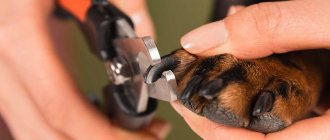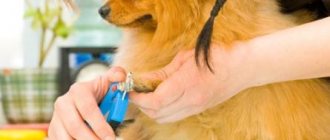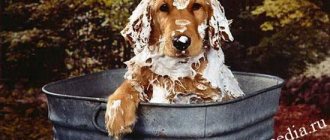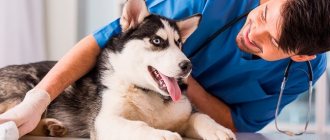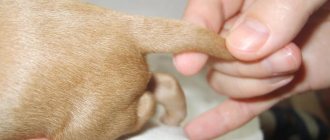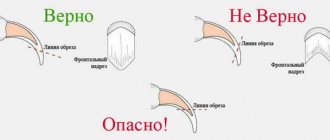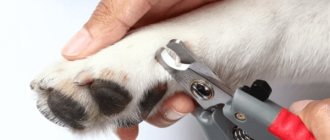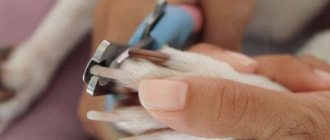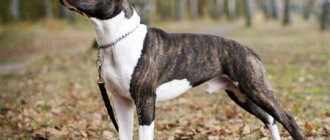Every dog owner cares about its upbringing, appearance and health. The complex of care procedures pays special attention to the paws and always includes trimming the dog’s nails. Although some owners believe that there is no need to cut off their pets’ claws and a dog manicure is a fashion statement, such a preventive measure has nothing to do with a beauty ritual. It prevents injury to the paws, their incorrect position and possible pain.
Natural abrasion of the claw or regular shortening
Dogs' claws, like human nails, grow constantly throughout life. This is their main similarity, but there is also a significant difference. When walking, the entire plantar surface of people's feet comes into contact with the ground, while dogs step only on the pads of their toes. Under ideal natural conditions for keeping a dog, the claws wear out and shorten purely mechanically upon contact with various types of soil. In this case, it is enough for the owner to check the paws only occasionally.
In practice, when kept at home, the claws grow faster than they can wear off - then they need to be trimmed regularly. How often a dog needs a pedicure depends on several factors:
- the type of soil on which you most often walk your dog;
- activity level;
- individual predispositions.
If your dog primarily travels on dirt roads, forests and meadows, his nails may not wear down quickly enough. The surface the paws come into contact with is too soft. In urban areas - on sidewalks, concrete paths or asphalt, mechanical removal of claws is much more effective. The same effect is obtained in cases where the dog loves (and has the opportunity) to dig holes, this is especially true for the Jack Russell.
Nail trimming is often necessary in older dogs because their physical activity decreases and therefore the potential for heavy abrasion decreases.
What should you buy?
The selection at veterinary stores can be confusing, but making a list ahead of time will help you stay organized and get everything you need. This way you will stock up only on the goods you need and will not waste money.
For a good dog pedicure, you don’t have to buy half the pet store.
Table 1. Tools needed to trim a dog's nails
| Item | Description |
Claw cutter | These scissors look like pruning shears. They have 2 handles and 2 blades. They are suitable for small breeds, but they are not always suitable for large dogs with hard claws. |
Guillotine | A tool that has slots to accommodate the claw. Thanks to the levers, a process is launched during which the claw is cut off. This device is suitable for dogs of any breed. The main thing is to choose the hole size |
File | In addition to the cutting device, you will need nail files. A carelessly cut claw can peel or even break. Files will allow you to round it and smooth out unevenness. |
Files can be either manual or electric. They come with several attachments that vary in level of hardness. By inserting the nozzle into the device and turning it on, you will see how the head begins to rotate very quickly. With this tool you can polish the claw, giving it the desired shape.
Why trim the claw
If your pet's nail plate is not wearing down quickly enough, you need to help him. This is not a matter of aesthetics, but above all of health, because too long nails can affect the comfort of your dog's life, preventing him from walking normally. Neglecting this procedure may have the following consequences:
- pain when walking
- posture and gait disorders
- joint degeneration
- paw hypersensitivity
- finger bone injury
- purulent-inflammatory conditions
- imbalance
- lameness.
Be careful!
Take special care in the following situations, which may lead to complications:
- If the animal was previously injured when you tried to trim its claws and now has an extremely negative attitude towards the procedure, then it is better to immediately contact a professional groomer or veterinarian;
If your dog has been injured once during nail trimming, subsequent sessions will be difficult for him.
- Do not refuse sedatives if the groomer offers them. There are often situations when even in clinics an animal experiences pain when cutting its claws;
- If the claw bleeds even 30 minutes after the end of the procedure, you should immediately contact a veterinarian for help.
Consequences of overgrown claws in a dog
Nails that are too long put pressure on the nail bed, which can cause the fingers to curl painfully over time. Nails can grow into the pads of the paws, which leads to their deformation and, as a result, increased stress on the joints. If you do not pay proper attention to nail care, the result may be
- pain when walking, running and jumping;
- paw hypersensitivity;
- the appearance of painful wounds;
- on smooth surfaces the dog often does not find sufficient grip and slips;
- Over time, there is a risk of increased muscle tone and poor posture.
This happens because the dog, in order to avoid pain, takes a rescue position and places its paws at the wrong angle. Oversized claws tend to curl and dig painfully into the animal's skin. In very active, dynamic animals that are in constant motion, such as the Jack Russell, the claws may even be torn out. Severely neglected paws increase the risk of lameness and arthrosis.
Treatment of wounds
Make sure your dog does not develop open wounds as a result of your actions. If any of the claws begin to bleed, do not let the dog run away from you and lick the wounds into a dark corner. You need to treat and disinfect the injured area.
Hydrogen peroxide will prevent infections from entering the wound on the paw
Apply a hemostatic agent to the damaged area. During the procedure, do not let go of the animal's paws. Soak a cotton pad in hydrogen peroxide or chlorhexidine and apply to the damaged area. Sit in a fixed position with your dog for a few minutes.
Be sure to comfort the animal and let it know that there will be no more discomfort from the procedure. Make sure that during this time the animal does not come into contact with the street and does not lick its claws.
By licking wounds on the paws, a dog risks introducing dangerous bacteria into them.
If bleeding does not go away or hemostatic agents do not help, be sure to visit a veterinarian or groomer. The dog will be given a special bandage and the wound will be treated with antiseptics.
When do you need nail trimming?
Many owners ask themselves this question, although the answer is surprisingly simple: when you can clearly hear your dog's footsteps on laminate or tile (as if scratching the floor), it's time for a pedicure.
Dog nails are the correct length when they do not protrude beyond the tips of the fingers. Therefore, when the dog is standing, its nails should end just above the ground, not touching it at all or only lightly.
Pruning should be done only when necessary and as rarely as possible. How to accurately determine the moment when the claws have reached a critical length? There is a very simple but effective way: slip a piece of paper under the dog's paw while he is standing. If you can't do this (the claws are digging into the floor), it's time for a haircut.
This should be done regularly, approximately once every four to six weeks. But here an individual approach is needed, taking into account the breed, living conditions and character of the animal. The first procedures are usually difficult, but then it becomes a normal and problem-free care ritual.
Other grooming procedures
Grooming a Jack is not just about trimming. It includes comprehensive care for the dog - from nose to tip of tail.
Bathing
Caring for the Jack Russell Terrier's coat begins with bathing. The dogs are clean, their fur cleans itself, so this part of grooming is problem-free.
The “jacks” are washed as they become dirty - every 3 months, maximum - once every 4 weeks.
You need to select special tools. Among them:
- shampoos for dogs with short or coarse hair;
- balm or conditioner - preferably one that does not need to be washed off;
- wool oils – optional.
Combing
Combing is the most common grooming procedure. It rids dogs of dead fur and stimulates blood circulation. In addition, dogs love her and regard the manipulation as additional attention.
“Jacks” are combed 1-2 times a week, during the molting period daily or every other day. Use a massage brush for smooth-haired breeds or a slicker brush for wire-haired varieties.
Since the Jack Russell has a tough coat, they prefer to care for their coat using a furminator. It collects dead hair better than any comb.
A haircut
In the classical sense, jacks don't need haircuts. Some owners prefer to clip rather than trim their dogs, but this is a detrimental position.
Grooming your Jack Russell Terrier is a quick, easy and cheap way of grooming. However, it harms the wool.
Wirehaired dogs have hair that is coarse at the end, but the base is thin. When you pull out old hairs, new hairs with the same structure grow. But if you cut them, they will start to grow from the weak part and lose their shape.
Therefore, Jacks only need a hygienic haircut. It consists of trimming:
- eyebrows, bangs, beard, mustache;
- hairs in the groin and around the anus;
- feathering on the neck and paws;
- tassels and dewlaps on the tail.
A Jack Terrier is trimmed with barber thinning scissors.
Caring for your ears, eyes and teeth
The Russell's funny face with button eyes also needs regular grooming:
- after eating, wipe the beard and mustache from food debris;
- the ears are cleaned with sponges once every 1–2 weeks, using a veterinary solution, chlorhexidine or a decoction of chamomile or calendula;
- eyes are wiped from oxides as necessary;
- You need weekly brushing of your teeth with a children's brush and toothpaste for dogs; toothpicks are given treats in between hygiene procedures.
Structure of a dog's claw
Before learning the ins and outs of trimming a dog's nails, it's worth becoming well-acquainted with their anatomy, as it directly impacts the precautions you need to take. The outside of the dog's nail is covered with a horny plate, under which there is more delicate and lighter tissue. The inner part of the claw is the pulp, which contains blood vessels and nerve endings.
Cutting off the horny plate is completely painless for the dog. However, disruption of the pulp can cause excessive bleeding and pain - the blood vessels and nerve endings passing there must not be damaged.
Don't let the nails get too long. Nerves and blood vessels located in the nail matrix migrate to the horny plate with the growing nail. When they get too close to the edge, the procedure for shortening to the desired length will become much more complicated (Fig. 2).
If the foundation has already gone too far, you need to be patient and use a nail file. With this tool you can safely, without haste, get rid of the unnecessary layer of the plate. Every week you can remove only the keratinized thin layer of the claw until the blood vessels go deep inside.
Precautionary measures
When trimming claws, you should be careful and precise. Even experienced dog owners are not immune to possible embarrassments.
Therefore, always have medical supplies on hand and follow these rules:
- Do not cut the nails too short - there should be at least 2-3 mm left to the pulp.
- If the stratum corneum is dark and you cannot determine the location of the soft tissue, cut off a very small piece. If there is a noticeable depression in the cut, this length is sufficient; a shorter length is not necessary.
- Keep bactericidal and hemostatic drugs on hand - iodine, manganese, blood-absorbing powder.
- File the cut area to smooth out sharp edges and prevent delamination.
- Along with pruning, carry out a preventive examination of the paws for wounds, damage, and fungus. Treat damage with an antiseptic. During the hot season, shorten the long hair between the toes for hygienic purposes.
Nail trimming tools
The right tool will make a dog manicure much easier and reduce stress for both dog and owner. Good nail clippers or special nail clippers will do a great job with a dog's manicure. These tools have a round blade shape and an optimized cutting angle, so they apply even pressure on the nail plate and cut without splintering or twitching. Human nail care tools are not suitable for dogs and can damage or break the nail, further increasing the dog's discomfort.
In addition to a steady hand, you will need the following accessories:
- scissors or nail clippers;
- wire cutters;
- nailfile;
- a good light source, such as a powerful flashlight.
If your nails only need to be shortened a little, a good file is enough. If you also want to remove fur between the toes, you'll need bandage scissors or baby scissors because both options have blunt, rounded tips that are safe for four-legged animals. There are also special models of nippers on the market that work on the guillotine principle and are equipped with a lock that prevents the cut of the claw from being too short. Some models also have a live claw sensor. It signals with a red light an area that cannot be cut, and a green light where it is safe to cut without damaging blood vessels and nerves.
If you feel unsure, you can try a power tool that works like a file. The risk of injury is much lower here; you just need to accustom your pet to the sound that this device makes.
The quality and sharpness of the tools. Before using wire cutters or scissors, make sure the blade is sharp enough. In stores you will find high quality tools with precision stainless steel blades that stay sharp for a long time. If necessary, you can also sharpen the tool.
Adviсe
Experienced owners on websites and forums share their observations on how to most effectively carry out such a procedure. Perhaps you will successfully apply some of these tips in the future:
- You should not cut off a claw if you could not get a good look at it. If the fur blocks your view, it is better to cut it;
In addition to veterinarians, groomers can also teach dogs how to trim their nails.
- If the animal does not sit quietly in place, then you will need the help of another person. It is necessary that he sits behind the dog and gently grabs its neck with his hand. In this case, the animal’s head must be fixed. With your other hand you need to grab the animal by the paw. This technique is more of a last resort, in case the dog is very worried;
- It is important to accustom your dog to trimming its nails at a young age, because puppies adapt to new procedures much more easily;
The sooner your puppy gets used to nail trimming, the easier it will be for him in the future.
- Do not raise your tone during the procedure. The dog should feel safe;
- If you are in a veterinary clinic and the animal was given a sedative before any procedure, ask the specialist to trim the pet’s nails at the same time. Many doctors agree to this even without additional payment.
How to Trim Nails Without Stress
Most dogs find nail trimming intimidating and don't like to have their paw pads touched. In order not to cause stress for both you and your pet, you must first get used to carrying out such a procedure yourself and accustom your dog to it.
Start by gently touching a part of the paw that is not a problem for the dog, such as the forearm or wrist. Encouraging the dog, move your hand lower and lower, to the fingers and nails. Be sure to reward him if he allows it and remains calm.
You can use the “give a paw” command if the dog is already well accustomed to it.
The next step is to get accustomed to the tools you will use. Let the dog see and smell them. If you use a power tool, be sure to familiarize your dog with the sound of the device. An unknown sound can frighten him and he will reflexively jerk his paw.
Try running it dry a few times before starting the trimming procedure. Try to remain calm and be sure to praise and reward your dog with a treat if he has learned to remain completely calm in this situation. If he is still very scared, limit trimming to one nail per day.
I'll start unconventionally, with horror.
On one of the social networks I saw these terrible photos:
My indignation knows no bounds. How is this possible? Is the owner of this dog blind?! Poor animal! Judging by the condition of the claws, no one has touched them for a year...
Remember the sensational story about how Italian lawyers ensured that a woman who had to miss work and care for her setter after surgery was paid two days of sick leave? I call this attitude towards animals civilized! A dog should be treated as a full-fledged member of the family!
Trimming claws step by step instructions
To make nail trimming as stress-free as possible, follow the step-by-step instructions.
- The right time: If you are nervous or having a bad day, you will transfer negative emotions to your dog. Postpone the procedure until you have regained your balance and calmed down.
- The Right Size: There is no one-size-fits-all tool that fits all breeds. The size of the tools should be chosen according to the size of the dog's nails. Smaller tools make trimming more precise for small dog breeds such as Jack Russell or Russian Toy. If the scissors or clippers are too large, there is a risk of damaging the base of the nail.
- Good lighting: Light the work area sufficiently to avoid damaging the nail shaft with blood vessels.
- Suitable position: It is most convenient to trim nails when the dog is lying on its side. Then you will have convenient access to each paw.
- Precision trimming: shorten each claw a little at first, one or two millimeters at a time, until it reaches the optimal length. It is best to cut the claw at an angle of approximately 45 degrees to the ground.
- Strong movements: Hold the tool firmly and vigorously and press on it - weak movements may simply pinch the claw.
- Polishing: After trimming, you also need to file your nails. Be sure to only move the file in one direction and not back and forth. This prevents the nail plate from splitting and chipping.
- Tasty ending: Don't forget to reward your dog for good behavior and patience. Over time, he will associate the not entirely pleasant procedure with something pleasant.
Cost of salon grooming
Professional grooming of a Jack is an expensive proposition. Thus, the average price of trimming in Moscow is 2,100 rubles, in St. Petersburg – 2,000 rubles. And the cost of a haircut is 2,000 rubles. and 1,500 rub. respectively.
A number of salons charge a separate fee for bathing - 600-800 rubles, and trimming nails - 350-500 rubles.
Grooming a Jack Terrier is not difficult, with the exception of trimming. Dead hairs need to be plucked every 3 - 6 months, and for show dogs - once every 1.5 months. Plus, the procedure is expensive – it costs from 2 thousand rubles.
Wolf's claw
Some breeds, mostly larger ones such as the French Shepherd or Czechoslovakian Wolfdog, have what are called wolf claws. This is the fifth toe on the inside of the hind paw. It is placed slightly higher than the other fingers. Most often it is underdeveloped and does not bear any functional load.
Since it does not come into contact with the ground and cannot be abraded naturally, hand trimming is required. If your dog has a wolf claw, check its length regularly. As it grows, it can cut into the skin and even injure the paw.
Despite its name, the wolf's claw is not a vestige of the dog's ancestors. Wolves do not have such a claw.
Caring for Jack
“Grooming” is a fairly new word in the Russian language. It means comprehensive body care, including washing, bathing, cutting, and cleaning various parts of the body. In general, this refers to caring for the human body, but in our country it is used quite narrowly and means comprehensive care for the dog.
Who else can please the eye as much as a clean, combed, well-groomed Jack? Only a very well-groomed Jack! To avoid problems with grooming, bathing, etc., accustom your puppy to all elements of grooming from the first days.
Regular grooming for an adult Jack includes grooming
,
trimming nails
,
cleaning eyes and ears
.
Grooming
As previously mentioned, Jacks come in 3 coat types: smooth, hard, and intermediate. Different types of wool require different care, which includes keeping it clean, combing, and trimming.
Being an active and inquisitive dog, your Jack will always find somewhere to get dirty, and given his white color, any dirt on him will be very noticeable. However, do not rush to bathe him every time he gets dirty (of course, if he did not roll around in some rotten meat, obeying the instincts of his ancestors).
During the process of breeding, Jacks developed wool that repels dirt. Simply wipe paws and dirty areas with a damp towel or special cleaning wipes. Dirt can be easily cleaned off. In general, try not to bathe your dog often.
Do this only as needed. Girls need to be bathed after the end of their heat. If you take Jack to a show, you will have to wash him before each show.
The fact is that frequent bathing dries out the dog’s skin, removes the natural protective layer, and leads to the formation of dandruff. Even if you use expensive shampoos for dogs, do not overdo bathing.
Jack is small in size, so you can bathe him in a basin. If you wash him in the bathtub, be sure to place a mat on the bottom so that his paws don't move apart and he feels secure.
Before bathing, place cotton swabs in Jack's ears to prevent water from getting in. Bathing water should be lukewarm, not hot.
